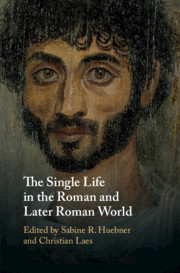Refine search
Actions for selected content:
23990 results in Ancient history
3 - Anatomy of an ‘Outrage’, 1862–1864
-
- Book:
- The Ghost of Namamugi
- Published by:
- Amsterdam University Press
- Published online:
- 30 April 2022
- Print publication:
- 28 February 2019, pp 48-88
-
- Chapter
- Export citation
1 - ‘Afloat and Settled in China’, 1853–1862
-
- Book:
- The Ghost of Namamugi
- Published by:
- Amsterdam University Press
- Published online:
- 30 April 2022
- Print publication:
- 28 February 2019, pp 11-27
-
- Chapter
- Export citation
PART I - The Many Deaths of Mr Richardson
-
- Book:
- The Ghost of Namamugi
- Published by:
- Amsterdam University Press
- Published online:
- 30 April 2022
- Print publication:
- 28 February 2019, pp 1-2
-
- Chapter
- Export citation
List of Abbreviations
-
- Book:
- The Ghost of Namamugi
- Published by:
- Amsterdam University Press
- Published online:
- 30 April 2022
- Print publication:
- 28 February 2019, pp xi-xi
-
- Chapter
- Export citation
Map of Locations
-
- Book:
- The Ghost of Namamugi
- Published by:
- Amsterdam University Press
- Published online:
- 30 April 2022
- Print publication:
- 28 February 2019, pp xii-xii
-
- Chapter
- Export citation
Note on the Text
-
- Book:
- The Ghost of Namamugi
- Published by:
- Amsterdam University Press
- Published online:
- 30 April 2022
- Print publication:
- 28 February 2019, pp xiii-xiv
-
- Chapter
- Export citation
Frontmatter
-
- Book:
- The Ghost of Namamugi
- Published by:
- Amsterdam University Press
- Published online:
- 30 April 2022
- Print publication:
- 28 February 2019, pp i-iv
-
- Chapter
- Export citation
2 - The British Empire and Bakumatsu Japan, 1862–1863
-
- Book:
- The Ghost of Namamugi
- Published by:
- Amsterdam University Press
- Published online:
- 30 April 2022
- Print publication:
- 28 February 2019, pp 28-47
-
- Chapter
- Export citation
Contents
-
- Book:
- The Ghost of Namamugi
- Published by:
- Amsterdam University Press
- Published online:
- 30 April 2022
- Print publication:
- 28 February 2019, pp vii-viii
-
- Chapter
- Export citation
Dedication
-
- Book:
- The Ghost of Namamugi
- Published by:
- Amsterdam University Press
- Published online:
- 30 April 2022
- Print publication:
- 28 February 2019, pp v-vi
-
- Chapter
- Export citation
PART II - The Letters of Charles Lenox Richardson, 1853–1862
-
- Book:
- The Ghost of Namamugi
- Published by:
- Amsterdam University Press
- Published online:
- 30 April 2022
- Print publication:
- 28 February 2019, pp 117-118
-
- Chapter
- Export citation
Note on the Letters and Acknowledgements
-
- Book:
- The Ghost of Namamugi
- Published by:
- Amsterdam University Press
- Published online:
- 30 April 2022
- Print publication:
- 28 February 2019, pp 119-240
-
- Chapter
- Export citation

The Single Life in the Roman and Later Roman World
-
- Published online:
- 18 February 2019
- Print publication:
- 14 February 2019
9 - Revisiting First Millennium BC Graves in North-West Morocco
- from Part III - Looking North
-
-
- Book:
- Burials, Migration and Identity in the Ancient Sahara and Beyond
- Published online:
- 21 June 2019
- Print publication:
- 14 February 2019, pp 281-312
-
- Chapter
- Export citation
Being Single in the Roman World
-
- Book:
- The Single Life in the Roman and Later Roman World
- Published online:
- 18 February 2019
- Print publication:
- 14 February 2019, pp 103-178
-
- Chapter
- Export citation
Copyright page
-
- Book:
- The Single Life in the Roman and Later Roman World
- Published online:
- 18 February 2019
- Print publication:
- 14 February 2019, pp iv-iv
-
- Chapter
- Export citation
Chapter 11 - Singles and Singleness in the Christian Epigraphic Evidence from Rome (c. 300–500 CE)*
- from Late Antique Christianity: The Rise of the Ideal of Being Single
-
-
- Book:
- The Single Life in the Roman and Later Roman World
- Published online:
- 18 February 2019
- Print publication:
- 14 February 2019, pp 227-258
-
- Chapter
- Export citation
Figures
-
- Book:
- Burials, Migration and Identity in the Ancient Sahara and Beyond
- Published online:
- 21 June 2019
- Print publication:
- 14 February 2019, pp viii-xv
-
- Chapter
- Export citation
17 - Concluding Discussion
- from Part VI - Linguistic Aspects of Migration and Identity
-
-
- Book:
- Burials, Migration and Identity in the Ancient Sahara and Beyond
- Published online:
- 21 June 2019
- Print publication:
- 14 February 2019, pp 525-548
-
- Chapter
- Export citation
Chapter 13 - Single Life in Late Antiquity? Virgins between the Earthly and the Heavenly Family
- from Late Antique Christianity: The Rise of the Ideal of Being Single
-
-
- Book:
- The Single Life in the Roman and Later Roman World
- Published online:
- 18 February 2019
- Print publication:
- 14 February 2019, pp 276-291
-
- Chapter
- Export citation
